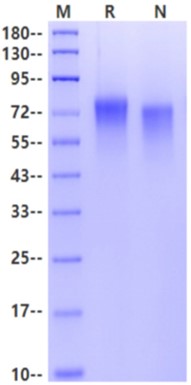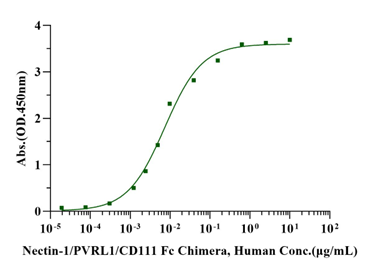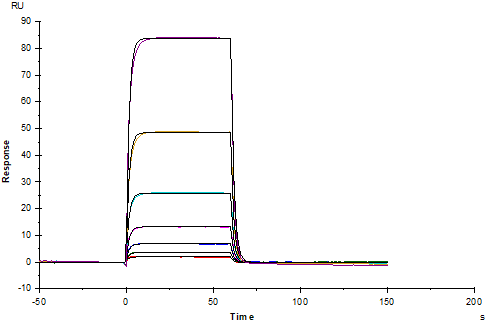Gly58-Asp400, with C-terminal 8*His
GPIIVEPHVTAVWGKNVSLKCLIEVNETITQISWEKIHGKSSQTVAVHHPQYGFSVQGEYQGRVLFKNYSLNDATITLHNIGFSDSGKYICKAVTFPLGNAQSSTTVTVLVEPTVSLIKGPDSLIDGGNETVAAICIAATGKPVAHIDWEGDLGEMESTTTSFPNETATIISQYKLFPTRFARGRRITCVVKHPALEKDIRYSFILDIQYAPEVSVTGYDGNWFVGRKGVNLKCNADANPPPFKSVWSRLDGQWPDGLLASDNTLHFVHPLTFNYSGVYICKVTNSLGQRSDQKVIYISDPPTTTTLQPTIQWHPSTADIEDLATEPKKLPFPLSTLATIKDDGGGSHHHHHHHH
65-85kDa (Reducing)
Reconstitute at 0.1-1 mg/ml according to the size in ultrapure water after rapid centrifugation.
1.Takai, Y. and H. Nakanishi (2003) J. Cell Sci.116:17.
2.Miyoshi, J. and Y. Takai (2007) Am. J. Nephrol.27:590.
3.Sakisaka, T. et al. (2007) Curr. Opin. Cell Biol.19:593.
4.Rikitake, Y. and Y. Takai (2008) Cell. Mol. LifeSci. 65:253.
Nectins are a small family of Ca++-independent immunoglobulin (Ig)-like cell adhesion molecules (CAMs) that organize intercellular junctions. The Nectin family has at least four members (Nectin-1 - 4), all of which show alternate splicing, a transmembrane (TM) region (except for Nectin-1 gamma ), and three extracellular Ig-domains. Nectin-3 (also named PRR3, CD113 and PVRL3) is an 83 kDa, type I TM glycoprotein. NECTIN3 is intended to initiate cell-cell adhesion to stimulate cell attachment and to allow subsequent formation of JAM-and cadherin-based intercellular junctions. NECTIN3 induces endocytosis-mediated down-regulation of PVR from the cell surface, which results in reduction of cell movement & proliferation. Following Nectin-3 activity adds strength to the junction through trans-interaction with various molecules.


Immobilized Nectin-3/CD113 His Tag, Human (Cat. No. UA010487) at 2.0μg/mL (100μL/well) can bind Nectin-1/PVRL1/CD111 Fc Chimera, Human (Cat. No. UA010016) with EC50 of 5.43-10.29ng/ml.

Protein A Chip captured Nectin-1/PVRL1/CD111 Fc Chimera, Human (Cat. No. UA010016), can bind Nectin-3/CD113 His Tag, Human (Cat. No. UA010487) with an affinity constant of 20.01μM as determined in SPR assay.